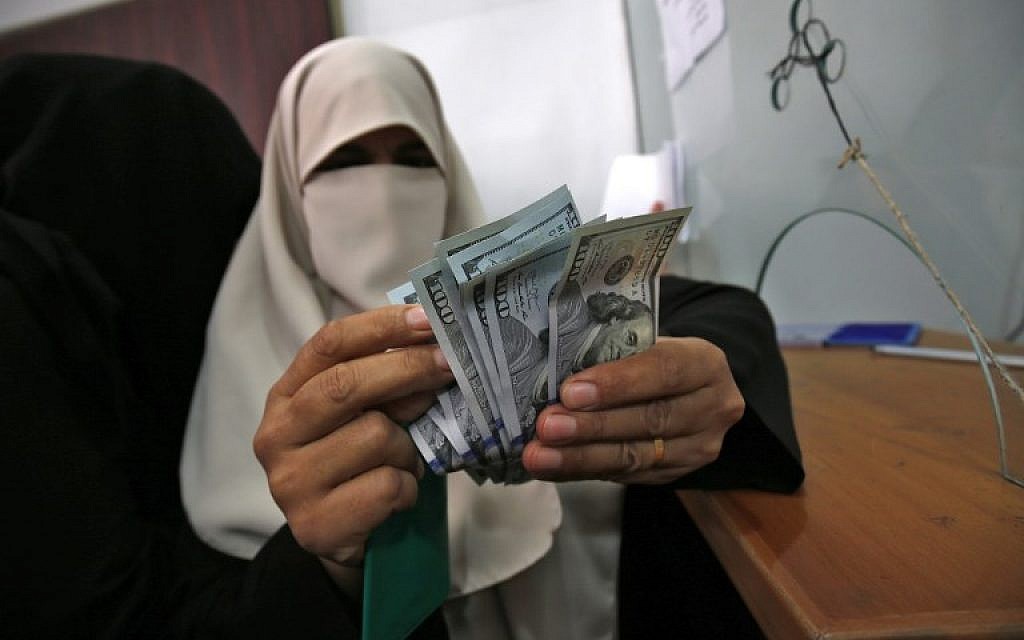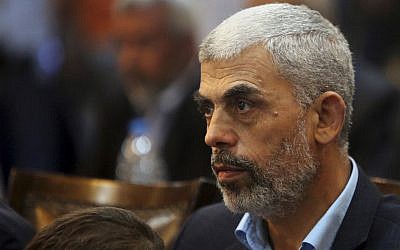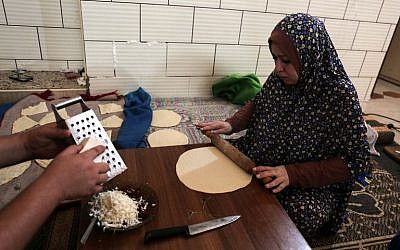While Gazans ascribe influx of money to weekly protests, and Israel buys some time, the PA could yet cut its own funding for the coastal enclave, plunging it into war

The images from Gaza on Friday showing hundreds of Hamas administration employees lining up to receive their salaries represent an important victory for the terrorist organization and its leaders, even if only a temporary victory.
Hamas leader Yahya Sinwar delivers what he promises, the images seemed to show.
Not only did the salaries of Hamas officials arrive, but the money entered the Strip with the blessing of the Israeli government — which, in the eyes of the Gazan public, has succumbed to the pressure created by thousands of protesters gathering at the border fence on a weekly basis, sending incendiary balloons and laying explosive charges.
In other words, for the umpteenth time, the Palestinian public has received decisive proof that the Jews only understand force.
After all, the way they see it, those same salaries could have been allowed into the Strip many months ago, either secretly or not, with the help of Qatar, but Israel chose not to allow this. And when did Israel’s position change? When the fields on its side of the border went up in flames, and fears of war became a reality.
Furthermore, just like the 2005 disengagement, which gave Hamas a huge victory in parliamentary elections a year later, this recent move was not coordinated with the Palestinian Authority and its leader, Mahmoud Abbas.

The many statements from associates of Abbas expressing strong opposition to the payment of salaries in this manner make clear how significant Hamas’s achievement is.
The PA had demanded that it be a conduit for the payments, and only after it had examined the names of the Hamas administration officials who would receive the cash. Qatari envoy Muhammad al-Amadi, who met with Abbas on the subject, heard his explicit objection. Yet the salaries were ultimately transferred without coordination, in cash-stuffed suitcases — a mob movie, Qatari-style.
Additionally, the move required no small amount of Israeli-Qatari coordination. A private Qatari plane landed at a side runway at a central Israel airport. Representatives of the Israeli defense establishment, together with Qatari envoys, then moved the suitcases of cash to government vehicles, which traveled to the Erez Crossing and then into Gaza. In other words, the Israeli government played a major role in facilitating the transfer in order to calm the situation in Gaza before it spiraled out of control.
And yes, things have calmed.
One Gaza resident with whom I spoke on Sunday said with great satisfaction that there is now electricity for eight hours at a time, followed by eight hours without. This is compared to four or five hours of electricity followed by a 16-hour break up until two weeks ago. The electricity is also being paid for by Qatar, allowing Hamas to use some of its funds for additional investments in the military wing and terrorist infrastructure, including tunnels and rockets.

So in the short term, Hamas and Israel can relax a little. Hamas has ensured the survival of its regime in Gaza — by means of a struggle, but not an all-out war that could have ended with the destruction of the coastal enclave. The terror group will receive credit for the improvement in Gaza’s economy, and will appear to have prevailed over the Israelis.
For its part, the Netanyahu government appears to have bought itself a few more months of quiet in the south, while continuing to claim that there is no Palestinian partner for peace, as Abbas is too weak and there is not just one Palestinian entity but two. Almost everyone got what they wanted.
But some questions remain unanswered. For one, no one knows how long the current arrangement can hold — the Qataris may decide to stop their monthly $15 million payments in six months, or not.
The wildcard is Abbas, who has previously threatened to stop the transfer of all PA funds to Gaza, but retracted the threat while the Egyptians were promoting a reconciliation agreement between Hamas and his Fatah faction. The question is whether in a few weeks or months Abbas may decide to stop the money anyway.
In light of the transfer of salaries from Qatar to Hamas, Abbas could decide that Gaza will need to get by without any PA funds. In such a scenario, it is doubtful that even Qatar’s cash-filled suitcases could stop a rapid deterioration into war.
As reported by The Times of Israel
